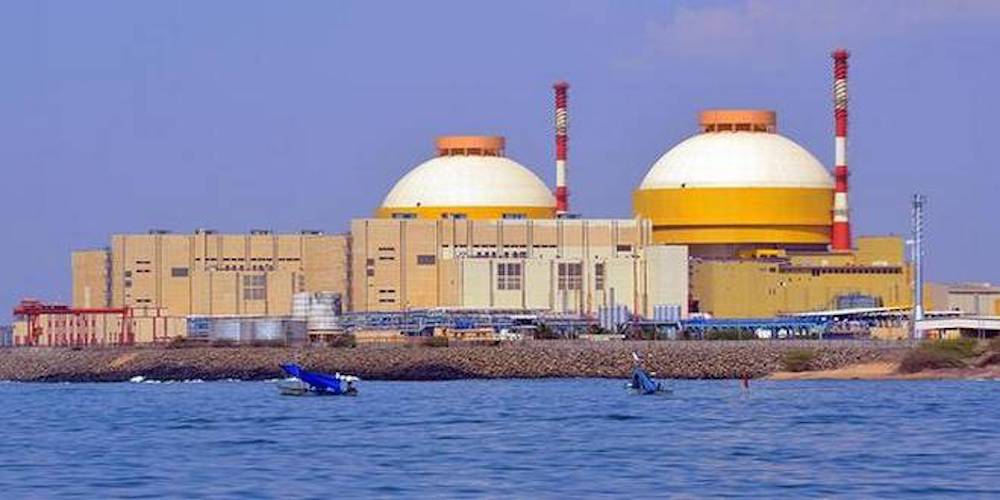Developing Atomic Energy

As India is not very rich in fossil fuel resources and considering the large and growing energy demand, all energy sources are deployed optimally. One such source is “nuclear power”, which is a clean and environment friendly base load source of electricity generation and available 24X7.
Nuclear power also has a huge potential and can provide the country long term energy security in a sustainable manner. Expansion of nuclear power capacity will help in the country’s energy transition for meeting the goal of a net zero economy.
It may be noted that Prime Minister Narendra Modi, in his statement at COP26 Summit held in Glasgow, has stated that India will reach its non-fossil energy capacity to 500 GW by 2030 and India will meet 50 percent of its energy requirements from Renewable Energy by 2030.
In this regard, a total of 79 no. of hydro schemes with an aggregate capacity of more than 30000 MW (comprising 11 Pumped Storage Schemes of 8700 MW) have been envisaged for capacity addition during the period 2019-2020 to 2029-30. This includes 12663.5 MW of HE projects under construction for providing benefits during this period. Out of the above 79 projects, 5 hydro schemes with capacity of 1023 MW have since been commissioned. Similarly total capacities of 31665 MW of coal based capacity are in the various stages of construction.
The existing nuclear power capacity of 6780 MW is going to be increased to 22480 MW by the year 2031 on progressive completion of projects under construction and accorded sanction. More nuclear power plants are also planned in future.
In addition to projects presently under construction (8700 MW), the Government has accorded administrative approval and financial sanction for setting up ten indigenous Pressurized Heavy Water Reactors (PHWRs) of 700 MW capacity each in fleet mode.
On the progressive completion of projects under construction and accorded sanction, the installed nuclear power capacity is expected to reach 22480 MW by the year 2031 which includes Prototype Fast Breeder Reactor (PFBR)[500 MW], being implemented by BHAVINI.
It is to be noted that Nuclear power is the fifth-largest source of electricity in India after coal, gas, hydroelectricity and wind power. As of November 2020, India has 22 nuclear reactors in operation in 7 nuclear power plants, with a total installed capacity of 7,380 MW. The seven plants are:
1. Kakrapar Atomic Power Station – 1993, Gujarat
2. (Kalpakkam) Madras Atomic Power Station – 1984, Tamil Nadu
3. Narora Atomic Power Station- 1991, Uttar Pradesh
4. Kaiga Nuclear Power Plant -2000, Karnataka
5. Rajasthan Atomic Power Station – 1973, Rajasthan
6. Tarapur Atomic Power Station – 1969 Tarapur Atomic Power Station – 1969, Maharashtra
7. Kudankulam Nuclear Power Plant – 2013, Tamil Nadu
In addition to the sanctioned projects, the government has also accorded ‘In-Principle’ approval of the following five new sites for setting up nuclear power projects:
– At Jaitpura(Maharashtra), in collaboration with France
– At Kovvada, Andhra Pradesh, in collaboration with the USA
– At Chhaya, MithiVirdi, Gujarat, in collaboration with the USA
– At Haripur, West Bengal, in collaboration with Russia
– At Bhimpur, Madhya Pradesh, indigenously
India is recognized globally as a nation with advanced nuclear technologies. India has developed comprehensive capabilities in all stages of nuclear fuel cycle namely; mining, uranium production, fuel fabrication, nuclear power production, spent fuel reprocessing and waste management.
So far Inter Governmental Agreement (IGA) for co-operation in peaceful uses of nuclear energy have been signed with the following eighteen(18) countries: Argentina, Australia, Bangladesh, Canada, Czech Republic, European Union, France, Japan, Kazakhstan, Mongolia, Namibia, Republic of Korea, Russia, Sri Lanka, United Kingdom, United States of America, Vietnam and Ghana.
Currently India has active participation with the US, France, Russia, Uzbekistan, Kazakhstan and Canada in the area of Nuclear Energy.



